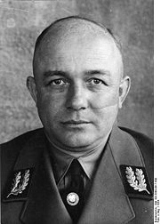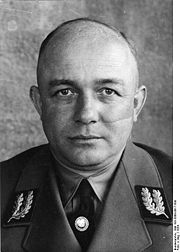
Helmut Bruckner
Encyclopedia

Gauleiter
A Gauleiter was the party leader of a regional branch of the NSDAP or the head of a Gau or of a Reichsgau.-Creation and Early Usage:...
of the National Socialist German Workers Party
National Socialist German Workers Party
The National Socialist German Workers' Party , commonly known in English as the Nazi Party, was a political party in Germany between 1920 and 1945. Its predecessor, the German Workers' Party , existed from 1919 to 1920...
(NSDAP) from 1925 until 1934.
Life
Helmuth Brückner was born on May 7, 1896 in Peilau (Prussia). He attended Volkschule in Peilau, Höhere Knabenschule in Langenbielau, and Kgl. Realgymnasium in ReichenbachReichenbach
- In Germany :* Reichenbach , in the Niederschlesischer Oberlausitzkreis district, Saxony* Reichenbach im Vogtland, in the Vogtlandkreis district, Saxony* Reichenbach am Heuberg, in the Tuttlingen district, Baden-Württemberg...
. He then studied at Friederich-Wilhelm-Universität in Breslau.
In 1914, Brückner volunteered for the Army and was posted with the Feld-Artillerie-Regiment 88 where he won the Iron Cross
Iron Cross
The Iron Cross is a cross symbol typically in black with a white or silver outline that originated after 1219 when the Kingdom of Jerusalem granted the Teutonic Order the right to combine the Teutonic Black Cross placed above a silver Cross of Jerusalem....
2nd and 1st Class as Leutnant der Reserve and Abteilung-Adjutant. On March 25, 1918, he was seriously wounded while in France. In 1921, he was Ib–Gruppe Nord with the Deutschen Selbstschutz (Freikorps) in Oberschlesien.
In 1924, Brückner joined the NS-Freiheitsbewegung (the NSDAP had been banned after the failed “Beer Hall Putsch
Beer Hall Putsch
The Beer Hall Putsch was a failed attempt at revolution that occurred between the evening of 8 November and the early afternoon of 9 November 1923, when Nazi Party leader Adolf Hitler, Generalquartiermeister Erich Ludendorff, and other heads of the Kampfbund unsuccessfully tried to seize power...
” in 1923) and became editor of Schlesien Volksstimme. He also became Stadtverordneter in Wroclaw
Wroclaw
Wrocław , situated on the River Oder , is the main city of southwestern Poland.Wrocław was the historical capital of Silesia and is today the capital of the Lower Silesian Voivodeship. Over the centuries, the city has been part of either Poland, Bohemia, Austria, Prussia, or Germany, but since 1945...
, a position he held until 1926.
Brückner organized the NSDAP in Silesia and on March 15, 1925, he officially joined the refounded NSDAP (number 2 023) and was appointed Gauleiter for Silesia
Silesia
Silesia is a historical region of Central Europe located mostly in Poland, with smaller parts also in the Czech Republic, and Germany.Silesia is rich in mineral and natural resources, and includes several important industrial areas. Silesia's largest city and historical capital is Wrocław...
. In September, 1930 he became a member of the Reichstag for Wroclaw (Wkr.8) and on April 24, 1932, he became a member of the Preußischen Lantags. On August 17, 1932 Brückner was named Kommissar Ost der NSDAP. It was at this time he also founded the publishing house NS-Schlesien which published the “Schlesischen Beobachters”.
On March 12, 1933, Brückner became Provinzial-Landtagsabgeordneter, Kreistagsabgeordneter and Stadtverordneter. On March 25, 1933, he became a Preußischen Staatsrat and the Oberpräsident in Wroclaw (while simultaneously being given temporary authority of Oberpräsident in Opole). On October 7, 1933 he became SA-Gruppenführer, but on December 25, 1934, he was expelled from NSDAP and dismissed as Gauleiter in connection with the "Röhm Putsch".
From 1938, Brückner was as an industrial worker in the Heinkel works in Rostock
Rostock
Rostock -Early history:In the 11th century Polabian Slavs founded a settlement at the Warnow river called Roztoc ; the name Rostock is derived from that designation. The Danish king Valdemar I set the town aflame in 1161.Afterwards the place was settled by German traders...
. He was politically rehabiliated, and in June 1940 was included in a group photograph at Führer Headquarters
Führer Headquarters
The Führer Headquarters , abbreviated FHQ, is a common name for a number of official headquarters used by the Nazi leader Adolf Hitler and various German commanders and officials throughout Europe during World War II...
as an SA-Obergruppenführer. He seems to have worn a toupée
Toupee
A toupée is a hairpiece or partial wig of natural or synthetic hair worn to cover partial baldness or for theatrical purposes. While toupées and hairpieces are typically associated with male wearers, some women also use hairpieces to lengthen existing hair, or cover partially exposed scalp...
at the time, as he is pictured in 1940 with considerably more hair than in his 1934 portrait.
Arrested by the Soviets in July, 1945, he was confined in a Thüringischen prison camp until 1949, then moved to the USSR where he was also in various internment camps. Official sources give his year of death as both 1951 and 1954, and appear to hide the date and place.

